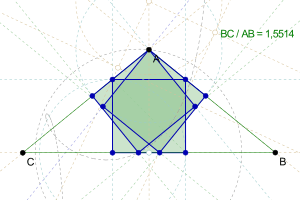Calabi triangle

The Calabi triangle is a special triangle found by Eugenio Calabi.[1] Consider the largest square that can be placed in an arbitrary triangle. It may be that such a square could be positioned in the triangle in more than one way. If the largest such square can be positioned in three different ways, then the triangle is either an equilateral triangle or the Calabi triangle.[2][3]
The Calabi triangle is isosceles. The ratio of the base to either leg is
which approximates to 1.55138752454. It is the largest positive root of
and has continued fraction representation [1, 1, 1, 4, 2, 1, 2, 1, 5, 2, 1, 3, 1, 1, 390, ...].[2]
The Calabi triangle is obtuse with base angles 39.1320261...° and third angle 101.7359477...°.
See also
References
- ↑ Eugenio Calabi (3 Nov 1997). "Outline of Proof Regarding Squares Wedged in Triangle". Retrieved 15 November 2012.
- 1 2 Calabi's triangle at Mathworld
- ↑ Conway, J.H.; Guy, R.K. (1996). The Book of Numbers. New York: Springer-Verlag. p. 206.
This article is issued from Wikipedia - version of the 1/3/2016. The text is available under the Creative Commons Attribution/Share Alike but additional terms may apply for the media files.